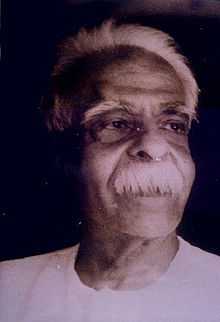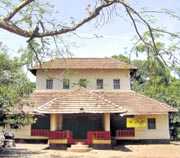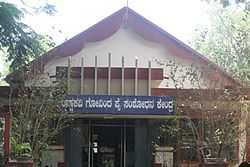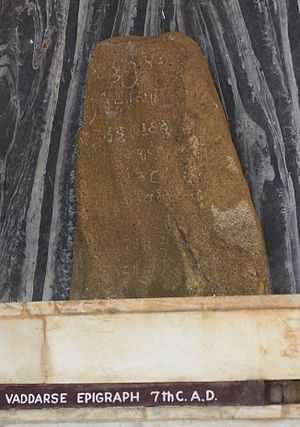M. Govinda Pai
| Manjeshwara Govinda Pai (ಮಂಜೇಶ್ವರ ಗೋವಿಂದ ಪೈ) | |
|---|---|
 | |
| Born |
23 March 1883 Manjeshwar, South Kanara, Madras Presidency, British India |
| Died | 6 September 1963 (aged 80) |
| Occupation | Writer |
| Nationality | India |
| Spouse | Krishna Bai[1] |
Manjeshwar Govinda Pai (Kannada: ಮಂಜೇಶ್ವರ ಗೋವಿಂದ ಪೈ)(1883–1963), also known as Rastrakavi Govinda Pai, was a Kannada poet. He was awarded the first Rashtrakavi title by the Madras Government (Kasaragod district was part of South Kanara district of Kerala State prior to the linguistic reorganisation of States on 1 November 1956[2]). Rashtrakavi M. Govinda Pai was the one who put Manjeshwar on the literary map of India.[3]
Early life
M. Govinda Pai was born on 23 March 1883 in a Konkani Goud Saraswat Brahmin family at his maternal grandfather's house in Manjeshwar.[1][4][5] He was the first son of Mangalore Sahukaar Thimmappa Pai and Devaki Amma. Govinda Pai went to school in Mangalore. For college education, Pai went to Madras (Chennai). Due to the sudden death of his father, he had to return.[4]

Career
Govinda Pai was also a prolific prose writer. His earliest composition in prose was Srikrishna Charita (1909) which makes for remarkable reading. Govinda Pai narrated the story of Christ's crucifixion in his work Golgotha (1931). The next three panegyrics published by him; Vaishakhi, Prabhasa and Dehali, narrated the last days of the Buddha, God Krishna and Gandhi respectively; were a result of the huge success of Golgotha.[6] His best works written in blank verse, viz., Golgotha (The last days of Christ, published in 1937), Vaisakhi (The last days of Buddha, published in 1946) and Hebberalu (The Thumb, the story of Ekalavya retold, published in 1946) have won a lasting place in the gallery of the greatest poets of Kannada literature.[7] Gommata Jinastuti was his first published work. He introduced the sonnet form into Kannada.[8] Hebberalu dramatises the story of Drona and Ekalavya, characters from the epic Mahabharata.[9]
Govinda Pai also enriched Kannada learning with his historical studies and research. He was an authority on the chronology and history of Tulunad. His works also testify to his universal outlook as well as to his deep compassion for the poor and the downtrodden.[10]
He was able to read and write fluently in 25 languages including Tulu, Sanskrit, Telugu, Tamil, Marathi, Bengali, Persian, Pali, Urdu, Greek and Japanese apart from Kannada, Konkani and English.[11] He translated several Japanese works into Kannada.
Works
His poems are...
- Gilivindu (1930) (parrot flocks)
- His first collection Gilivindu consists of 46 poems exhibits poets perspective towards life, his love for the country, his responsiveness to the nature around him and his love for Kannada.
- Nandadeepa (The enduring lamp)
- His Nandadeepa consisting of 37 poems, a tribute of devotion to God. Sri Pai's name will be remembered for ever in the realm of Kannada language as well as in the minds of Kannada people.[1]
- Hrudayaranga[12]
His other works are...
- Hebberalu (On Ekalavya)
- Chitrabhanu (On Quit India movement)
- Vaishaki (About the last days of the Buddha)
- Mannina Sogadu
- Taayi

Legacy
In 1949, the then Madras Government conferred on him the Rashtrakavi award. He was the president of Kannada Sahitya Sammelana at Bombay in 1951.[4]
On his 125th birth anniversary, a national award was instituted in his name and his old house at Manjeshwar is mooted to be a national monument.[4]
In Udupi near his native place, the Govind Pai Research Institute is established near MGM College of Dr. T.M.A Pai Foundation of Manipal instituitions. Other centres in the vicinity are Yakshagana & Janapada Samshodhana Kendra, Kanakadasa Peetha and Tulu lexicon project.[4]
Govind Pai was also acknowledged by the government of Kerala. The Govind Pai Memorial College is a part of Kannur University in Manjeswar is a testimonial for this.[4]

Govind Pai attended the Intermediate Course at Government College, Mangalore. It was here that he had Panje Mangesh Rao as one of his teachers. Panje was another pioneer of the Modern Kannada literary renaissance. Govind Pai had once asked Panje for the text of two songs which Panje used to recite. Panje used to borrow literary journals from Govind Pai, who, even as a lad of 13, had developed a taste for books and had started subscribing to literary journals.[1]
On the occasion of Govind Pai's 125th birthday celebration at Manjeshwar, foundation stone for the 'Gilivindu Project' was laid. The Union government and state governments of Kerala and Karnataka jointly took the initiative to build a memorial by planning a project called 'Gilivindu' at an estimated cost of Rs 20 million, which will consist of an open amphitheater, venue for staging plays, art exhibitions, Yakshagana, library section, preservation of manuscripts, research, comparative studies, archives, guest house for scholars etc.[13]
The Indian Oil Corporation (IOC) foundation would meet the expenses to renovate the Govinda Pai memorial building into a museum, library and an auditorium. The initiative was part of the ‘Gulivindu’ project, launched by the Kerala and Karnataka governments, to develop the poet’s ancestral house here into a national level centre of literature, culture, and research.[14]
Though Govind Pai today exists for us in the form of his poems, plays essays and such other literary and non-literary works, his life was so full of events and his personality so impressive and his accomplishments were so various that they have been recorded by many writers who were captivated by them and these records also recreate his life for us. Govind pai's circle of friends and readers was so large that in the commemoration volume brought out in Kundapur in the year 1965 no fewer than 70 writers, all eminent and didstinguished writers in their own merit, sketched the remarkable qualities of the genius that Govind pai was. Govind pai's rich personality, reflected in his works, gets further focus in these reminiscences.[1]
Poetic composition in Kannada was largely conventional around the turn of the century. On the prescription of all poets invariably used to maintain the initial rhyme in versification. Govind Pai too adhered to this practice in the early stages of his career. His first poem "Suvasini" was published in the journal of the same name The first poems to be published in "Swadeshabhimani" were "Subhadra Vilapa" and "Kaliya Mardana". These poems had the initial rhyme. These rhymed poems were published in the journal Swadeshabhimani from 1903 to 1910.
But slowly Govind Pai began to ask whether initial rhyme was so essential to poetry. Sanskrit poetry and English poetry did not have this element but that did not detract from their merit. Once Govind Pai made bold to ask Panje Mangesh Rao about his opinion on giving up rhyme. He seemed to imply that writing without rhyme meant a lack of poetic skill. Govind Pai was not satisfied with the response. But he still hesitated to deviate from the trodden path. Some poems which he wrote without rhyme he destroyed. But when he was in Baroda in 1911 he finally made up his mind to renounce rhyme. But today Govind Pai's route of deviation has become the royal path.[1]
Artefacts available at M Govinda Pai Regional Research Centre Udupi
See also
References
- ↑ 1.0 1.1 1.2 1.3 1.4 1.5 M. Thirumaleshwara Bhat; Neerkaje Thirumaleshwara Bhat (1 January 1993). Govind Pai. Sahitya Akademi. ISBN 978-81-7201-540-4. Retrieved 23 July 2013.
- ↑ Kasaragod District
- ↑ Venkat Madhurao Inamdar: "Govinda Pai"
- ↑ 4.0 4.1 4.2 4.3 4.4 4.5 "Kannada Writers – Rashtrakavi M. Govind Pai".
- ↑ "M.Govinda Pai:A Kannada Scholar-Poet ,an Indian Image of Universal Religion".
- ↑ Das (1995), p. 148
- ↑ Kasargod – Eminent Personalities
- ↑ "MEN OF LETTERS – Rashtrakavi, M. Govinda Pai".
- ↑ Murthy (1992), p. 175
- ↑ "MEN OF LETTERS – Rashtrakavi, M. Govinda Pai".
- ↑ "Rastra Kavi Govind Pai was Well-versed in 25 Languages".
- ↑ "GOVINDA PAI M., 1883–1963".
- ↑ "Foundation Stone Laid for 'Gilivindu Project' at Manjeshwar".
- ↑ "Poet's house to get an upgrade".
External links
| Wikimedia Commons has media related to M. Govinda Pai. |
- Kannada Writers – Rashtrakavi M. Govind Pai
- GOVINDA PAI M., 1883–1963
- M. Govinda Pai
- ಗೋವಿಂದ ಪೈ ಸ್ಮಾರಕಕ್ಕೆ ಆಧುನಿಕ ಸ್ಪರ್ಶ
- ಎಂ. ಗೋವಿಂದ ಪೈ
- ರಾಷ್ಟ್ರಕವಿ – ಮಂಜೇಶ್ವರ ಗೋವಿಂದ ಪೈ
|







